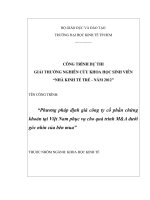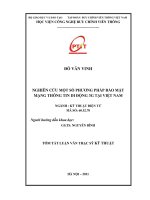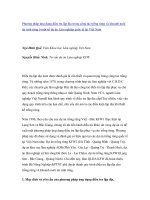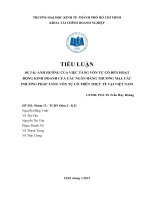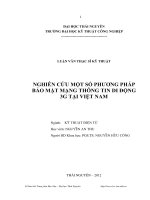PHƯƠNG PHÁP HỌC DỰA TRÊN NHỮNG NHIỆM VỤ THỰC TẾ TẠI VIỆT NAM: NHỮNG HIỂU NHẦM VÀ ĐỀ XUẤT
Bạn đang xem bản rút gọn của tài liệu. Xem và tải ngay bản đầy đủ của tài liệu tại đây (627.7 KB, 14 trang )
<span class='text_page_counter'>(1)</span><div class='page_container' data-page=1>
<b>TASK-BASED</b>
<b>LANGUAGE</b>
<b>TEACHING</b>
<b>IN</b>
<b>VIETNAM:</b>
<b>MISUNDERSTANDINGS</b>
<b>AND</b>
<b>SUGGESTIONS </b>
<b>Chi Do Naa* </b>
<i>a<sub>The Faculty of Foreign Languages, Angiang University, Angiang, Vietnam </sub></i>
<b>Article history </b>
Received: August 14th<sub>, 2017 </sub>
Received in revised form (1st<sub>): October 22</sub>nd<sub>, 2017 | Received in revised form (2</sub>nd<sub>): November 02</sub>nd<sub>, 2017 </sub>
Accepted: November 03rd<b><sub>, 2017 </sub></b>
<b>Abstract </b>
<i>Task-based language teaching (TBLT) has been extensively researched and applied in many </i>
<i>education settings due to the belief in its effectiveness in maximizing learners’ language </i>
<i>competency. Although this issue is not a new concept in language education, </i>
<i>misunderstandings of TBLT do exist, which leads to further misapplications of the pedagogy. </i>
<i>Besides, the reality of teaching and learning may not make TBLT a preferred method. This </i>
<i>paper therefore takes as its aims the common misunderstandings when applying TBLT in </i>
<i>Vietnamese education settings. The author investigates how TBLT is frequently mistakenly </i>
<i>perceived by language educators and provides suggestions on how to design language tasks </i>
<i>with specific implications of TBLT in an EFL classroom. </i>
<b>Keywords: Misapplications; Misunderstandings; Suggestions; Task-based; Task design. </b>
<b>1. </b> <b>INTRODUCTION </b>
Improving learners’ communicative competence is one of the major goals in
language education (Barnard & Nguyen, 2010), and appropriate teaching approaches are
essentially in need to transmit the language knowledge to learners and to unpack that
knowledge for authentic use. Researching teaching methods to achieve that goal,
Harshbarger (2002) and Phuong (2016) claim that Presentation - Practice - Production
(PPP) is no longer effective since the chances and possibilities to use the target language
for communication and negotiation are very limited, which goes against the goals of the
Ministry of Education and Training (MOET). Hence, the proposed solution is shifting to
Task-based language teaching which is believed to be more efficient in developing
</div>
<span class='text_page_counter'>(2)</span><div class='page_container' data-page=2>
learners’ communicative ability (Barnard & Nguyen, 2010; Harshbarger, 2002; Phuong,
2016).
Task-based language teaching (TBLT) has been applied in many language
education settings due to its effectiveness in developing learners’ language competency.
Emphasizing the popularity of TBLT, Ruso (2007) sees TBLT as the way forward in EFL
education which is highly preferred by numerous EFL teachers. Since 1980s, TBLT has
been taken into consideration, and literature concerning TLBT has also been extensively
brought out in order to provide more insightful evaluation of this pedagogical practice
(Ruso, 2007). It is explained that TBLT is greatly concerned about need-analysis and a
focus on how learners apply their language knowledge to complete a task which should
be authentic to language outside classrooms (Ellis, 2009; Nunan, 2004). Ellis (2009)
further supports the usefulness of TBLT, stating that natural use of the target language is
the main goal of language learning. However, through his research and observation of
how TBLT is applied in language education, he realizes that there are seemingly
misunderstandings of what TBLT really means. Explained by Ellis (2009), each
educational setting has its own goals and features that may not always accept TBLT as
the primary or most effective pedagogy. What is more, teachers who follow traditional
approaches may find it impractical and inappropriate to apply TBLT if the course
objectives may prioritize accuracy over fluency in which grammar is still of ultimate
importance.
</div>
<span class='text_page_counter'>(3)</span><div class='page_container' data-page=3>
<b>2. </b> <b>MISUNDERSTANDINGS OF TBLT </b>
In order to explore the difficulties when applying TBLT in EFL education in
Vietnam, the first issue is to define what a task is and whether a task is misunderstood.
<b>2.1. </b> <b>What is a task? </b>
Defining a task has been a subject of debate. A pioneering study on language tasks
is from Prabhu (1987, p. 24) who sees a task as "an activity which required learners to
arrive at an outcome from given information through some process of thought, and which
allowed teachers to control and regulate that process". Willis (1996) also agrees that a
task is an activity in which the focus is to thrive learners’ interaction to reach the task
outcome. A task, in Nunan (1989, 2004) view, is not solely an activity but any classroom
work where the focus is not restricted linguistic features, but meaningful communication.
Learners need to use a variety of linguistic features to interact, manipulate, and complete
the tasks. The ideas of aforementioned researchers can be combined with the work of
others (Branden, 2006; Ellis, 2009; & Skehan, 1998) to point out the consensus when
<i>defining a task. A task, in sum, can be seen as an activity or a series of activities which </i>
usually contain one or more problems to be solved or an intended outcome, and language
use and interaction are involved in order to solve the problems with the primary focus on
meaning.
</div>
<span class='text_page_counter'>(4)</span><div class='page_container' data-page=4>
learners to use language for meaningful communication. The communication can be done
with a diverse use of language features to complete the tasks which are authentic to daily
life contexts.
From these definitions, numerous issues can be further investigated since
educators who claim that they do apply TBLT in their teaching may mistakenly perceive
a task (Ellis, 2009). The misconception of the task is seen by Ellis (2009) as the basis of
further misunderstandings and misapplications. The misinterpretations can be seen in
relation to misleading focus on restricted grammatical features over meaningful
communication and the inappropriate task design which limits learners’ language use for
interaction and communication.
<b>2.2. </b> <b>The misleading focus in a TBLT classroom </b>
Language teaching has confronted two contrasting trends of whether the goal or
the focus of language education is on communicative competence or grammatical
structures. Derived from these two views are the notions of “focus on form” and “focus
on forms”. According to Sheen (2002) and Long (1991), the former prioritizes meaning
or communication practices in which learners make use of diverse language features for
their interactions and communication. The latter, on the other hand, aims at specific
language features that learners are expected to acquire. Normally, learners are explicitly
taught specific grammar points and practice how to use those. Although Sheen (2002)
makes no claims on which approach is more effective, he contends that TBLT is more
likely to refer to “focus on form” which allows learners’ engagement in meaning and
ensure the naturalness of language use. Referring back to the claim of learning a language
for authentic interaction, the “focus on form” approach is concluded to be more
appropriate in helping language learners extensively exploit their language competence
to complete a task. From this point, arguments occur since many researchers and
educators, even those from Vietnam, claim that the educational circumstances in Vietnam
do not always have a place for “focus on form” (Hoang, 2013; Le, 2014).
</div>
<span class='text_page_counter'>(5)</span><div class='page_container' data-page=5>
Nguyen, 2010). However, in many cases, grammar and vocabulary are still the central
objectives. EFL learners in Vietnam from elementary to higher education, except English
majors, have been oriented to pay for much attention to grammatical structures, reading
exercises, and grammar practice exercises (Hoang, 2013; Le, 2014).
Learners are frequently given what Ellis (2009) calls “instructional grammar
exercises” as a form-focused activity. A very common question that learners usually see
<i>is that “Complete/Rewrite the following sentences using [name of the structure]”. This </i>
exercise, in Ellis’ view, can never be seen as a task since it is form-oriented to put learners
in a situation that they need to practice the target grammatical structures that they have
learned. Unfortunately, Ellis (2009) realizes that those exercises are several times
mistakenly viewed as tasks though they do not stimulate any interaction or
communication among learners. This focus-on-forms curriculum is in fact so widespread
that the majority of teaching refers to explicit clarifications of grammatical points and
practice how to use those features (Barnard & Nguyen, 2010; Hoang, 2013). This is seen
as teaching for exams, not for skill development; Therefore, it is not relevant to TBLT
principle of giving learners opportunities to use language for interactions, and by
extension, for future authentic language use. As a concluding remark, TBLT does not
completely ignore need to help learners acquire linguistic features, teaching the target
language should not be explicitly stated in the instructions (Bonces & Bonces, 2010; Ellis,
2009). Otherwise, learners will be restricted to a certain number of features and ignore
other possibilities of language use to complete the tasks. Only when the target language
is completely ignored may teachers provide some directions, but still in an implicit
manner (Ellis, 2009).
<b>2.3. </b> <b>Learners’ inadequate interaction and language proficiency </b>
</div>
<span class='text_page_counter'>(6)</span><div class='page_container' data-page=6>
learned without emphasizing on or being limited to a particular form of language.
<i>Bachman (1990) and Ellis (2009) name this as interactional authenticity, indicating that </i>
the contexts of language use in classroom settings effectively reflect what learners
encounter in their real-life interactions. However, the problem occurs because opponents
of TBLT say that a majority of language learners are not proficient enough to complete
language tasks and the further question on the possibility of using the target language as
the means of communication in TBLT (Hoang, 2013; Le, 2014; & Nguyen et al., 2014).
Barnard and Nguyen (2010), and Le (2014) review an extensive amount of
literature concerning TBLT in Vietnam in relation to learners’ language proficiency. It is
unfortunate that the shift from traditional Grammar-Translation and Audio-Lingual
methods to a more communicative learner-centered approach like TBLT is not easy and
applicable in many settings due to the issue of learners’ limited language levels.
Explained by these researchers, EFL teachers frequently claim that learners may not be
proficient enough to carry out the tasks. However, this excuse for not applying TBLT as
the result of learners’ being unable to use language for interactions is contended by Ellis
(2009). He clarifies that interactions in TBLT do not only exist among advanced language
learners. In fact, higher levels of language proficiency allow learners to collaborate with
much more complicated language use and more effective task completion, but it is not
the basis without which there would be no interactions. With limited language resource,
beginners are still able to interact based on their strategic competence (e.g. raising
<i>questions, using synonyms). He takes the example of the meaning of the word dot. In a </i>
<i>conversation, a learner being unaware of its meaning may simply raise the issue by asking </i>
<i>what that word means, and the peer uses other words like a small point to clarify its </i>
meaning. All of these are still counted as interactions, and it is also potential for
acquisition. Eventually, interactions among language learners at a low level still exist
though limited. Ellis (2009) further explains that limited-proficiency learners exploit their
linguistic resource to complete a language task in different ways. The result of this is the
acquisition or development of language, though at a low level.
</div>
<span class='text_page_counter'>(7)</span><div class='page_container' data-page=7>
compatible with learners’ language proficiency. He indicates that language educators
when designing language tasks may not take a look back at their learners’ proficiency to
avoid the gap between the level of task difficulty and language competency, leading to
unsuccessful task completion.
<b>3. </b> <b>CHARACTERISTICS OF A TASK </b>
In order to effectively design a task, Ellis (2009) recommends some elements that
a task should obtain. Those ideas are significant because numerous researchers have also
come to an agreement on what has been proposed by Ellis. Researching TBLT in
Vietnamese context, Barnard and Nguyen (2010) also propose quite numerous issues to
consider in designing language tasks.
Firstly, the focus on a task is on meaning-making, so there should be no attempt
to focus on practicing a particular grammatical structure. In fact, structures and other
language utterances are more likely to be means for semantic and pragmatic indication.
Talking about focus on forms, Ellis (2009) classifies tasks into two categories, focused
and unfocused tasks. In his words, unfocused tasks are designed with an aim of creating
contexts for using language for general communication, which means there is no
restriction to any types of linguistic features. The focused tasks, on the other hand, do aim
at providing learners with chances to use language for interactions, but there is an aim to
focus on certain types of linguistic features. However, it is strongly advised that the target
language feature must be hidden or without any explicit indication on using that target
language in the instruction or task requirement. Since TBLT is associated with
learner-centered approach, the goals in designing tasks should focus on students’ needs and
performances (Nunan, 2004).
</div>
<span class='text_page_counter'>(8)</span><div class='page_container' data-page=8>
<i>Thirdly, there is an expectation that learners need to base on their own linguistic </i>
resources to complete a task. In other words, learners are expected to use whatever they
have, either linguistic or non-linguistic resource, to participate in a task (Bonces &
Bonces, 2010). Full exploitation of linguistic resources can help learners strengthen their
language skills and fluently use those resources for authentic interactions.
<i>The three criteria above are related to what Nunan (2004) calls active learning. </i>
Stated by Nunan (2004) and Ellis (2009), TBLT aims to create an environment where
learners can use the target language at most. Therefore, when designing a task, teachers
should keep this principle in mind so that he/she can stimulate learners’ language use.
Nunan (2004) also reminds that teachers may provide some input so that learners have
the basis for task completion, but they should not force learners to follow a particular way
<i>or set up a model for learners to follow. Otherwise, it will become a situational grammar </i>
<i>exercise. </i>
</div>
<span class='text_page_counter'>(9)</span><div class='page_container' data-page=9>
<b>4. </b> <b>PEDAGOGICAL IMPLICATIONS ON TASK DESIGN </b>
In this section, I will employ an example to see how to meet the four
previously-mentioned requirements. The topic of the example is ordering food at a restaurant with a
visual aid of the menu.
The implementation of TBLT in EFL classrooms has been extensively
investigated by researchers with numerous strategies and guidelines. Two of the models
that are widely talked about are Ellis (2003) three stages of pre-task, during task, and
post-task and Willis (1996) three-staged model including pre-task, task cycle, and
language focus. Despite being named differently, the stages in these two models share
many common views. In this section of the paper, I will provide suggestions on how to
design a task and how that task fits what researchers (Bonces & Bonces, 2010; Ellis, 2009;
& Nunan, 2004) require.
<b>Figure 1. The example menu </b>
Source: /><b>4.1. </b> <b>Pre-task </b>
</div>
<span class='text_page_counter'>(10)</span><div class='page_container' data-page=10>
stage implicitly prepares learners for the main tasks by developing learners’ vocabulary,
ideas, other language features, or just initial thoughts of the topic of the main task. The
activities that can be used in this stage include brainstorming ideas or words of the topic,
using visual aids (e.g. pictures, videos) to create the awareness of the language used for a
particular topic, or providing learners some questions related to the topic to elicit some
ideas for that topic.
Referring to the specific scenario in a restaurant and suggestions made by Ellis
(2003), Rozati (2014), and Willis (1996), activities suggested for the pre-task stage can
be varied.
<b>Table 1. Suggested activities in the pre-task stage </b>
Pre-task Task principles
Option 1:
Discussions: Teacher can provide students
some questions about eating in a restaurant to
help familiarize them with the main task
Do you usually eat in a restaurant?
What is your favorite restaurant?
What food do you usually eat in a restaurant?
This stage matches what Barnard and
Nguyen (2010); Ellis (2009); and
Nunan (2004) suggest on giving
learners chances to use their language to
solve the problems implied in a task. In
this case, learners can use their
language resource to (1) make
conversations based on guided
questions, (2) point out relevant words
from pictures, and (3) figure out how
language is used on the particular case
of food ordering through the video.
Option 2
Teaching vocabulary through pictures:
Teacher shows a number of pictures about
food, staff, and activities in a restaurant and
elicits the answers from students.
Option 3:
Priming through video: Teacher shows a video
about eating and ordering food in a restaurant,
followed by some questions about the video
concentrating on the food, the language use,
and some structures.
<b>4.2. </b> <b>Task cycle </b>
</div>
<span class='text_page_counter'>(11)</span><div class='page_container' data-page=11>
<b>Table 2. Steps in the task-cycle stage </b>
Task cycle Task principle
Step1:
Preparation
In this step, students are divided into pairs
or small groups. In each group, some
students will play the roles of customers,
and others will be waiters or waitresses.
The “customers’ students make a plan of
what they are going to order and may
negotiate with peers on how to use
language for ordering purpose. The
“waiters” groups will make a plan of what
they need to do to serve the customers and
what language features may be used for that
purpose. Teachers will go around to
facilitate but not to assign a specific
structure for students.
This stage of completing the main
task is what researchers (Barnard &
Nguyen, 2010; Ellis, 2003; & Willis,
1996) highly encourage, namely the
use of language for interaction and
communication to complete a task.
In this stage, learners need to use
whatever language resource they
have to conduct meaningful
communication with peers. This also
matches the idea of active learning of
Nunan (2004) who focuses on
creating an environment where
collaboration is stimulated and
communication is of high
importance.
Referring to the second principle on
language gap (Barnard & Nguyen,
2010; Nunan 2004), during this stage
of high volume of interaction,
learners will realize the gap in their
language competency which
prevents them from successfully
completing the task. They will then
fill in that gap with facilitation from
their peers or teachers.
Step 2:
Planning to report
Students will have a look at their list of
ideas, words, structures and allocate the
roles for their group members. It should be
ensured that all students are involved in the
conversations and upcoming report.
Students are allowed to ask teachers for
clarifications.
Teachers can check students’ work by
looking at their notes, providing feedback
on any points in the notes. Accuracy should
also be paid attention to. Teachers need to
make sure that students know what to do
and have their roles in the report.
Step 3: Reports
Students will be allocated in groups
including both customers and waiters. They
will make conversations based on their
notes to have the food ordered properly.
The conversations happen with various
settings such as asking for menus, asking
about food, ordering food, tipping, and
giving feedback on food. Teachers listen to
the conversations and take careful notes on
students’ performances for feedback after
the presentations. Questions are also
encouraged in this step.
<b>4.3. </b> <b>Language focus </b>
</div>
<span class='text_page_counter'>(12)</span><div class='page_container' data-page=12>
<b>Table 3. The language-focus stage </b>
Language focus Task principle
Language
analysis
Teachers may ask students what words or
phrases were used in a particular part of the
presentations. Or, teachers may simply
repeat the phrases used by students in the
presentations. Then, if errors occur, there
should be corrections on those. Besides, an
analysis on the use and forms of certain
words and structures is done by the teachers
to help the students acquire those features.
In doing this, the teachers emphasize on not
only how the language is used but also what
cultural and behavioral aspects the students
need to keep in mind as their life experience.
Similar to the previous stage,
teachers’ eliciting linguistic features
from students’ performances will
help students recognize their
language gap and fill that gap.
Besides, Nunan (2004) emphasizes
on not only language development
through task completion but also
cultural awareness. Since there will
be explanations on behavioral aspects
in a restaurant in different settings,
teachers will be able to introduce
certain cultural points related to
eating out in other cultures to
students.
Practice
Teachers can assign homework to students.
The homework, suggested by Rozati (2014),
can be any kinds of activity to get students to
practice what they have been instructed. So,
in this particular case, teachers can ask
students to write a report on their eating-out
experiences. Guided questions can be
provided.
Source: Willis (1996)
<b>5. </b> <b>CONCLUSION </b>
</div>
<span class='text_page_counter'>(13)</span><div class='page_container' data-page=13>
there has been a suggestion on how to design a task, there is still the need to apply that
task into a real-life teaching context to see how TBLT is implemented and whether more
issues exist when applying TBLT.
<b>REFERENCES </b>
<i>Bachman, L. (1990). Fundamental considerations in language testing. Oxford, UK: </i>
Oxford University Press.
Barnard, R., & Nguyen, G. V. (2010). Task-based language teaching (TBLT): A
<i>Vietnamese case study using narrative frame to elicit teachers’ beliefs. Language </i>
<i>Education in Asia, 1(1), 77-86. </i>
Bonces, M. R, & Bonces, J. R. (2010). Task-based language learning: Old approach, new
<i>style, a new lesson to learn. PROFILE Issues in Teachers’ Professional </i>
<i>Development, 12(2), 165-178. </i>
<i>Branden, K. V. D. (2006). Task-based language teaching: From theory to practice. </i>
Cambridge, UK: Cambridge University Press.
<i>Ellis, R. (2003). Task-based language learning and teaching. Oxford, UK: Oxford </i>
University Press.
Ellis, R. (2009). Task-based language teaching: Sorting out the misunderstandings.
<i>International Journal of Applied Linguistics, 19(3), 221-246. </i>
Harshbarger, L. (2002). What works in the ELT classroom? Using robust reasoning to
<i>find out. English Teaching Forum, 40(4),</i>18-25.
<i>Hoang, V. V. (2013). The current situation and issues of the teaching of English in </i>
<i>Vietnam. Retrieved from </i>
LCS_22_1pp7-18_HOANG.pdf.
Le, V. T. (2014). Factors affecting task-based language teaching from teachers’
<i>perspectives. Study in English Language Teaching, 2(1), 108-122. </i>
Nguyen, T. H., Warren, W., & Fehring, H. (2014). Factors affecting English language
<i>teaching and learning in higher education. English Language Teaching, 7(8), </i>
94-105.
<i>Nunan, D. (1989). Designing tasks for the communicative classroom. Cambridge, UK: </i>
Cambridge University Press.
<i>Nunan, D. (2004). Task-based language teaching. Cambridge, UK: Cambridge </i>
University Press.
<i>Prabhu, N. S. (1987). Second language pedagogy. Oxford, UK: Oxford University Press. </i>
Phuong, H. Y. (2016). Challenges of shifting to Task-based language teaching: A story
</div>
<span class='text_page_counter'>(14)</span><div class='page_container' data-page=14>
Robertson, M. (2014). Task-based language teaching and Expansive Learning Theory.
<i>TESL Canada Journal, 31(8), 187-198. </i>
<i>Rozati, S. M. (2014). Language teaching and Task-based approach. Theory and Practice </i>
<i>in Language Studies, 4(6), 1273-1278. </i>
<i>Ruso, N. (2007). The influence of Task-based learning in EFL classrooms. Asian EFL </i>
<i>Journal, 3(1), 147-172. </i>
<i>Sheen, R. (2002). “Focus on form” or “Focus on forms”. ELT Journal, 56(3), 303-304. </i>
<i>Skehan, P. (1998). A cognitive approach to language learning. New York, USA: Oxford </i>
University Press.
<i>Willis, J. (1996). A framework for task-based learning. London, UK: Longman. </i>
<b>PHƯƠNG</b>
<b>PHÁP</b>
<b>HỌC</b>
<b>DỰA</b>
<b>TRÊN</b>
<b>NHỮNG</b>
<b>NHIỆM</b>
<b>VỤ</b>
<b>THỰC</b>
<b>TẾ</b>
<b>TẠI</b>
<b>VIỆT</b>
<b>NAM:</b>
<b>NHỮNG</b>
<b>HIỂU</b>
<b>NHẦM</b>
<b>VÀ</b>
<b>ĐỀ</b>
<b>XUẤT </b>
<b>Chi Đô Naa* </b>
<i><b>a</b><sub>Khoa Ngoại ngữ, Trường Đại học An Giang, An Giang, Việt Nam </sub></i>
<i>*<sub>Tác giả liên hệ: Email: </sub></i>
<b>Lịch sử bài báo </b>
Nhận ngày 14 tháng 08 năm 2017
Chỉnh sửa lần 1 ngày 22 tháng 10 năm 2017 | Chỉnh sửa lần 2 ngày 02 tháng 11 năm 2017
<b>Chấp nhận đăng ngày 03 tháng 11 năm 2017 </b>
<b>Tóm tắt </b>
<i>Phương pháp học dựa trên những nhiệm vụ thực tế (Task-based language teaching) từ lâu </i>
<i>được nghiên cứu và ứng dụng rộng rãi trong giảng dạy tiếng Anh vì những lợi ích trong việc </i>
<i>phát triển năng lực ngôn ngữ của người học. Dù phương pháp này khơng cịn mới mẻ nhưng </i>
<i>vẫn cịn tồn tại nhiều khó khăn khi ứng dụng phương pháp này trong giảng dạy do những </i>
<i>hiểu nhầm về phương pháp này. Bài nghiên cứu tổng quan này sẽ phân tích những hiểu nhầm </i>
<i>thường gặp khi ứng dụng Phương pháp học dựa trên những nhiệm vụ thực tế tại Việt Nam. </i>
<i>Bài viết sẽ tìm hiểu những hiểu biết chưa thỏa đáng về phương pháp học dựa trên những </i>
<i>nhiệm vụ thực tế và đề xuất giải pháp để thiết kế các nhiệm vụ thực tế có hiệu quả trong dạy </i>
<i>và học tiếng Anh. </i>
<i><b>Từ khóa: Ứng dụng sai; Hiểu nhầm; Các đề xuất; Nhiệm vụ thực tế; Thiết kế nhiệm vụ thực </b></i>
</div>
<!--links-->
<a href=' /> Vận dụng một số phương pháp thống kê phân tích lượng khách quốc tế đến Việt Nam giai đoạn 1995-2005
- 96
- 594
- 1

